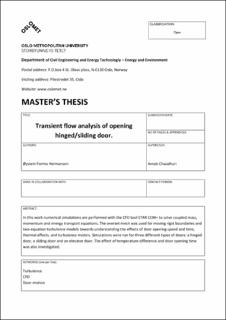| dc.description.abstract | Most people spend the majority of a day indoors where temperature and air quality have a big impact on their work performance, comfort and health. To be able to control the spread of diseases in indoor environments it is crucial to understand the indoor air flows. An important part of this is to look at the different factors which effects the way the air moves. Understanding of air flow and mass exchange by the opening of a door is beneficial for estimation of pollutant transport and this makes us able to better predict and control desired indoor environment. In this thesis Numerical simulations were performed to solve coupled of mass, momentum and energy transport equations. The focus of this work was the usage of the overset mesh for moving rigid boundaries and two-equation turbulence models towards understanding the effects of door opening speed and time, thermal effects, and turbulence models. This work is also very relevant to the present pandemic situation. The simulations involve three different types of doors. One hinged, one sliding and one elevator door. In addition to the different door types, it has also been performed simulations with different opening times and thermal effect. Besides how the door moves the geometry and boundary conditions are the same for each case. To track the air exchange between the two rooms sulfur hexafluoride (SF6) tracer gas was used.
To verify the CFD methods used in the thesis a test case that is similar in both physics and geometry to the simulations previously reported by the other researchers in the literature have been reproduced. When reviewing the flow field and the velocity It is evident from the comparison that the solutions from the reproduced model agree well with the literature. The comparison of the opening and closing door motions times for the hinged and the sliding door shows that the total time of the motion affects the airflow. Lower opening time creates a higher velocity and more exchange between the two rooms.
For the non-thermal simulations visual comparison was done by monitoring the mass fraction of SF6 in a scalar scene and the velocity with the use of the Line Integral Convolution (LIC) in the vector scene. The results clearly shows that the hinged door creates most exchange of air and creates the most velocity in the airflow. The sliding door and the elevator door has less effect. The cumulative mass of SF6 exchanged through the door opening was also monitored and showed that the hinged door has the biggest impact. Time snaps at different timesteps of velocity and mass flux shows the same trend with the biggest effect from the hinged door.
For the thermal cases is also shown that the hinged door creates most exchange of air and creates the most velocity in the airflow. Still the sliding door and the elevator door seems to be most affected by the temperature. Meaning that these cases show a clearer difference compared to the non- thermal case. The cumulative mass of SF6 exchanged through the door opening is also closer to hinged door. The time snaps at different timesteps shows the same trend with the most change in velocity and mass flux for the elevator and the sliding door. The hinged door is also seen the dominant force for the thermal case but it is seen clearly that the temperature difference effects the airflow.
It can be concluded that STAR CMM+ is a powerful tool and that the overset mesh works well for the purpose of simulating solid movements. Using the overset mesh is a demanding process in the start-up phase, but this type of CFD simulations provide valuable information for estimation of pollutant transport and prediction of desired indoor environment. The results are also relevant for energy use, the thermal simulations of the cold storage room in particular. | en_US |
